Sourdough Hoagie Rolls
Sourdough Hoagie Rolls! Hoagie, hero, sub, grinder, whatever you call your sandwich, this is a great roll for building your masterpiece.

Table of contents
Why these are is the best Sourdough Hoagie Rolls
Whatever you call it, there is no doubt that the key to a great sandwich is the perfect long roll.
The perfect sourdough hoagie roll should have a thin, crisp crust and a light, soft, slightly chewy crumb. This recipe makes the perfect sourdough hoagie roll.
By the way, if you don’t have a sourdough starter, you can make Hoagie Rolls with commercial yeast.
How to make Sourdough Hoagie Rolls
See the recipe card for detailed measurements and instructions.
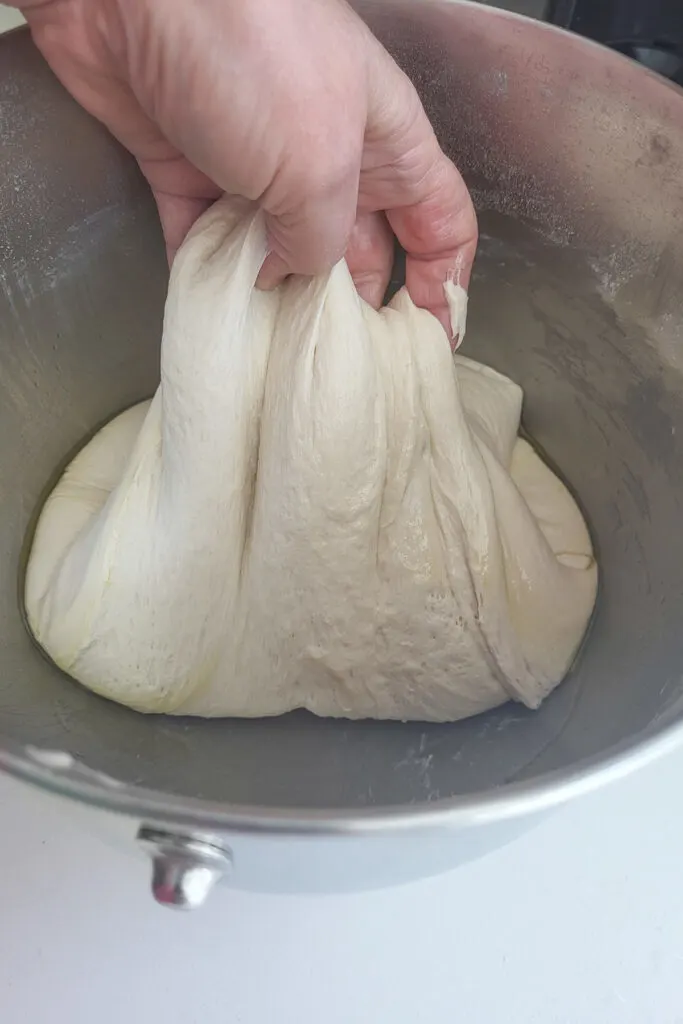
- After mixing the dough. Set it aside for 3-5 hours at room temperature.
- Every hour fold the dough to aerate and develop the dough.
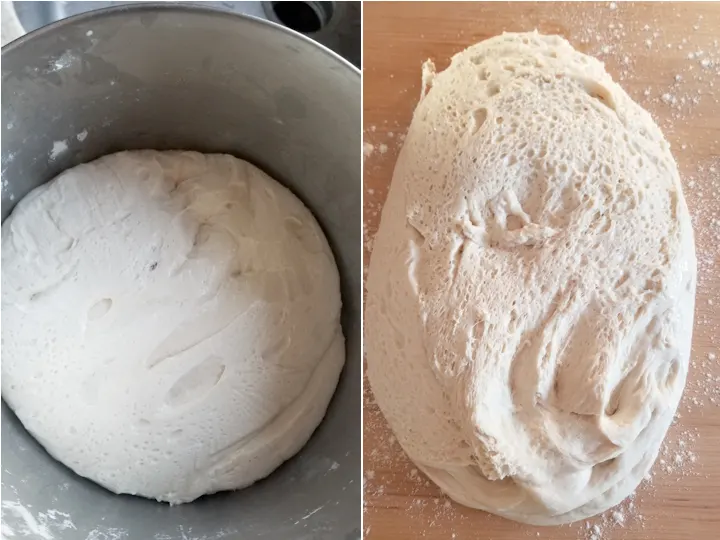
- After the initial fermentation at room temperature. Cover the bowl and refrigerate.
- Leave the dough to ferment overnight in the refrigerator.
- In the morning the dough should be well-aerated and ready for shaping.
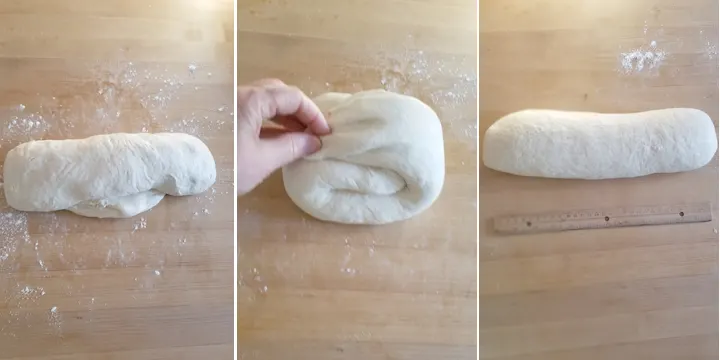
- Roll the dough to a 12″ log.
- Fold the two ends of the log towards the center.
- Roll the dough to a 12″ log again.
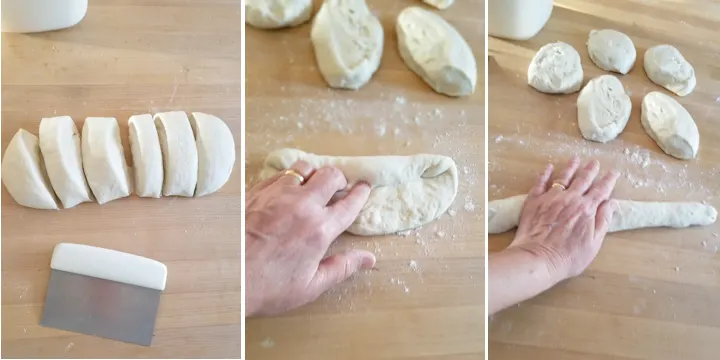
- Cut the dough into 6 pieces.
- Form each piece into an oval and roll the oval into a small log.
- Roll the dough to 10″ long.
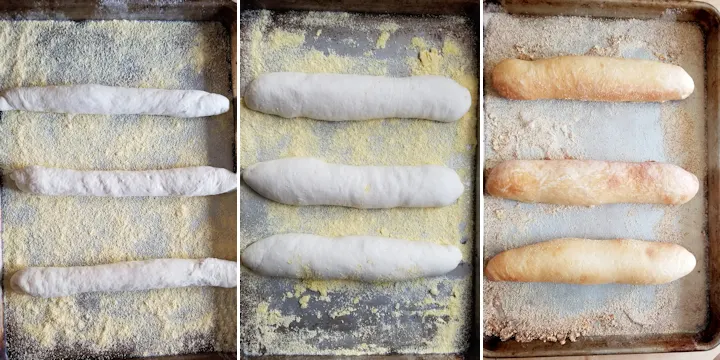
- Set the rolls onto a sheet pan to rise.
- Rise until doubled in size.
- Bake until golden brown.
A timeline for making Sourdough Hoagie Rolls:
- If your starter needs feeding, do that the night before or early in the morning of the day you want to make the dough.
- Mix the dough in the afternoon. Allow it to ferment at room temperature all day and refrigerate the dough in the evening before going to bed.
- The dough can stay in the refrigerator for 2-3 days at this point.
- Take the dough out first thing in the morning and shape the hoagie rolls.
- Leave them at room temperature to rise for 1 1/2- 2 hours.
- If you want to bake the same day, feed the starter the night before. Make the dough early in the morning and leave it to ferment until the afternoon. Form the rolls and leave them to rise, skipping the refrigeration step. Bake the hoagie rolls in time for dinner.
Storage
Sourdough Hoagie Rolls will keep at room temperature for 1-2 days but they’re best the day they are baked. Leftovers can be frozen for up to a month. Defrost and warm in a 200F oven to re-crisp the rolls.
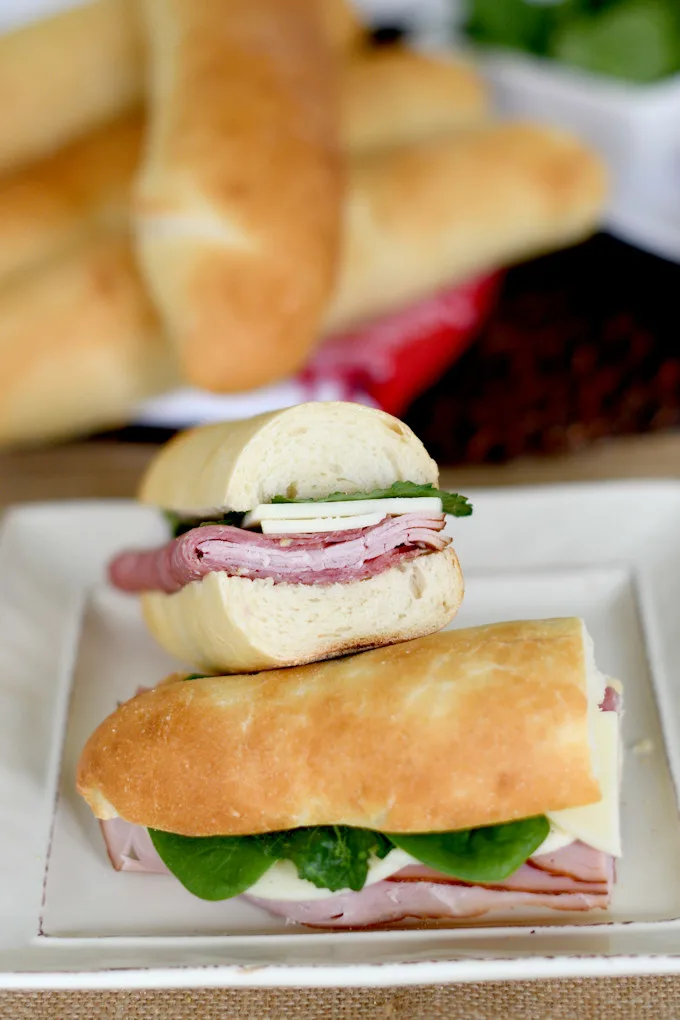
I know you love a good sandwich, so I highly recommend my Sourdough White Sandwich Bread and my Sourdough Whole Wheat Bread. Sourdough Rye Bread is also the base for a great sandwich.
Since you’ve got your starter fed, peruse the entire list of My Best Sourdough Recipes. Have fun!
I know you hate to throw away that sourdough discard. Check out these recipes that use sourdough discard.
If you love this recipe as much as I do, I’d really appreciate a 5-star review.
Sourdough Hoagie Rolls
Ingredients
- 8 oz Active Sourdough Starter (1 cup)
- 1 tablespoon granulated sugar
- 8 oz warm water (1 cup)
- 12 ½ oz unbleached all purpose flour (2 ½ cups, see note)
- 4 oz milk (½ cup, scalded and cooled to room temperature)
- 7 ½ oz unbleached bread flour (1 ½ cups)
- 2 teaspoons table salt
- cornmeal (for the sheet pans)
Instructions
- In a large mixing bowl or in the bowl of a stand mixer, combine 8 oz Active Sourdough Starter, 1 tablespoon granulated sugar and 8 oz warm water. Add 2 cups (10 oz) of the all purpose flour. Mix with the paddle on low speed until it forms a thick batter. Cover the bowl and set aside for 30 minutes.
- Add 4 oz milk, 7 ½ oz unbleached bread flour and 2 teaspoons table salt then mix to combine. If using a stand mixer, switch to the dough hook. With the mixer running, add the remaining all purpose flour. Knead the dough for 5 minutes until it is smooth and elastic. If mixing by hand add the flour using a wooden spoon and/or a plastic bowl scraper and knead by hand. Turn the dough out onto a floured surface and shape into a smooth ball.
- Transfer the dough to a lightly oiled bowl, turning once to coat the dough. Cover the bowl and set it aside at room temperature. After an hour, working from four corners of the dough (still in the bowl) use your hand to lift the top edge of the dough over into the middle of the dough. Repeat with the other 3 sides then flip the dough over. Every hour or so check on the progress of the dough by folding it over itself in the bowl. After about 3 hours the dough should be lively, elastic and airy. If the dough is still sluggish give it another hour or two at room temperature.
- Cover the bowl tightly, refrigerate overnight. At this point the dough can be held in the refrigerator for up to 2 days.
- In the morning, take the dough out of the refrigerator. Generously sprinkle 2 half sheet pans with corn meal.
- Turn the dough out onto a lightly floured surface. Without kneading, form the dough into a 12" log. Fold the two ends into the middle then roll back and forth to form a 12” log again. If at any point the dough springs back too much you can give it a 10 minutes rest then continue. Cut the log into 6 equal portions.
- On a lightly floured surface, pat a piece of dough into a 6” oval. Tightly roll the dough from the long side to form a 6" cylinder. Pinch the seam tightly. Using flat hands roll from the center out to form a 10” long roll. Let your hands go over each side to taper the ends of the roll. Set the roll onto one of the prepared pans. Continue forming the other rolls and place 3 on each pan.
- Cover the pans with a damp kitchen towel and set aside in a warm place to rise until doubled in volume (about 2-2 1/2 hours). The rising time will vary based on the temperature of the dough and the ambient temperature. Meanwhile, preheat the oven to 450 °F.
- To create steam in the oven, place a small pan onto the floor of the oven to preheat. If you have them, you can put lava rocks or whiskey rocks into the pan to preheat as well.
- When the rolls are ready to bake brush them lightly with milk. Place the trays in the oven. Pour a 1/4 cup of warm water into the preheated pan on the floor of the oven and immediately close the oven door.
- Bake until the rolls are golden brown, about 15-20 minutes. Turn the trays after 10 minutes to promote even browning. Cool completely on a wire rack before slicing.
Would you like to save this recipe?
As an Amazon Associate and member of other affiliate programs, I earn from qualifying purchases.








What other flour can be used to make those buns other than on purpose flour?
You could use all bread flour but you may want to use slightly less since bread flour will absorb more liquid than ap flour. You could also use whole wheat flour in place of ap flour for a wheat hoagie.
I don’t have cornmeal to put on the pan, can I just use flour?
You could use parchment paper or flour.
This recipe is amazing! I will definitely bake again! I used my starter straight out of the fridge and it came out really well. I was worried about it a little. I find that the I like the bread to be a bit saltier. Is it wise to add more salt in the dough or will that mess up the recipe?
You could up the salt a smidge. But be careful. Too much salt could retard the yeast.
I have all-purpose flour but not bread flour. Can I used whole wheat for bread flour?
The bread flour is used to have more protein (gluten) in the dough. Whole wheat has less protein than bread flour and the whole grain can slightly weaken the gluten structure. You’d be better off using only ap flour. Because is has lower protein, ap flour doesn’t absorb quite as much liquid as bread flour does. So you’ll probably need to add a little more flour if you don’t use bread flour. I suggest you mix the dough as listed, then at the end if the dough is very wet sprinkle in more flour a tablespoon at a time.
Made these yesterday and they are delicious. My husband LOVED them! The texture was perfect. He has already asked me to make your sourdough sandwich loaf. I look forward to trying lots of your recipes so thanks for sharing so many.
This turned out amazing! (And your responses to the comments are also amazing)
I’ve made these twice thus far and couldn’t be happier. This recipe is definitely a keeper. The first time I made them into round rolls for Jackfruit Barbecue sandwiches. The bread absorbed the sauce and held its structure beautifully.
The second time we made long rolls for subs. We sliced the rolls and spread hummus as the base, added red pepper relish as well as oil and vinegar to our sandwiches which also had lettuce, onion, tomatoes, avocado, roasted peppers, kalamata olives and cucumbers.
The sandwiches were made the night before so when lunch break came I fully expected a soggy (but tasty) mess and had knives and forks on hand to use. To my surprise, we were able to pick up our sandwiches and eat them without any problems. It didn’t crumble or dissentigrate, the outside was crisp but not hard and the inside was moist and flavorful. The bread was sturdy enough to handle the ingredients, but the crumb was easy to bite and chew.
Even with all of the moist ingredients no one needed extra napkins. 10 outta 10 I will definitely make these again!
Thanks! I make these all the time. We use them for meatball sandwiches.
Something seems off. This comes out to a 44% hydration which is really really low hydration. 1 1/2 cups liquid (1 cup water, 1/2 cup milk) and 4 cups of flour (2 1/2 cups AP flour, 1 1/2 cups bread flour). The starter is 100% hydration, bringing it to 2 cups liquid and 4 1/2 cups flour with the starter.
I couldn’t even get all the last 1/2 cup of AP flour to incorporate it was so dry. I wet my hands to knead the dough to try and get what was already in there incorporated.
It rose very slowly and is in the fridge now. It is a very tight dough. I will see if I can make them into rolls tomorrow, but what am I missing here?
You can not figure out the hydration based on volume measure since a cup of flour does not weigh the same as a cup of liquid. You need to do the percentage by weight. 1 cup water (8oz) plus 1/2 cup milk (4oz) plus 4oz water in the starter = 16oz liquid total. 2.5 cups ap flour (12.5 oz) plus 1.5 cups bread flour (7.5 oz) plus 4 oz flour in the starter adds up to 24 oz of flour total. 16/24 = 66% hydration. 66% is well within normal hydration for bread dough.
What can I substitute the milk with? Would like to make this non-dairy.
Can I use water and add a fat?
That little bit of milk softens the crumb and crust. You can try using a nut milk but not sure you’d get the same results.
I don’t have bread flour and wanted to start these today. Will it completely change the rolls if I use all white flour?
The strong gluten from bread flour helps the rolls get a chewy texture. The rolls will work with all AP Flour, they just might have a softer texture. You may also need to sprinkle in a little more flour since higher protein bread flour absorbs more moisture than ap flour.
Can you explain step 3. Are these stretch and folds over 3 hours. Are we looking for the dough to rise any in those 3 hours or longer. It’s a bit confusing to me.
Yes, the dough should rise over those 3 or so hours. The exact time will depend on the condition of your starter, the temp of the dough and the room temp. The stretches and folds are to redistribute the yeast and to develop the gluten.
@Eileen Gray, so I am still confused. I have baked regular boules and usually bulk ferment happens after the stretch and folds. If the dough is on the counter for 3 plus hours and in that time I am performing stretch and folds, won’t it knock the air out?
Yes, it will knock some air out. But then the dough goes into the fridge for the night and will rise slowly. These are hoagie rolls. We’re not looking for big, uneven holes in the dough that you’ll often see in a rustic loaf. It’s a sandwich bread so it will have a smaller, more regular crumb.
how many grams is each roll if we are to scale them out before rolling? I put the formula into excel and have no idea what the original amount of dough was. How much to scale each roll? Thank you!
I weigh the dough before portioning and divide by 6. For example, if you had 1200g of dough each roll would be 200g.
Can this be done with all bread flour?
I use a combination of the two flours because you don’t want the hoagie rolls to be too chewy. If you only have bread flour you might want to hold back 1/4 cup because the high protein bread flour will absorb more water.
Wonderful recipe! My dough was happy after an overnight in the refrigerator. For anyone who felt the dough was too loose, don’t fear the dough – it shaped up beautifully in three hours in my 72 degree kitchen. Followed the recipe exactly with the exception of making smaller rolls. This one’s a keeper!
When do you add the 1-1/2 cups Unbleached bread flour?
I keep reading the recipe and can’t find what step to add it. I only see the 2-1/2 cups of all purpose being used.
In step 2 it says to add the bread flour.
What can I use as a bread flour substitute?
What is the purpose of scalding the milk? Can a milk substitute be used (ie..almond milk)? If so, than would that need to be scalded as well?
There is a protein in milk that inhibits gluten formation. Scalding the milk helps mitigate that process. You can use a milk substitute but there would be no need to scald since the milk protein wouldn’t be in the substitute. The results might be a bit different with non-dairy milk, but the recipe should still work.
How firm/runny should the dough be? I mixed it in a mixer and it’s pretty runny. I can’t take it out of the bowl with my hands. I had to pour it out. I ended up adding 30g more of bread flour. It was still pretty runny but not as bad.
The dough will start out quite wet, but the texture will develop over the long fermentation. With this type of dough I don’t try to lift it with my hands, I use a dough scraper. Also, in the morning when you shape the dough it will be easier to handle when it’s cold from the fridge.
I made these! The rose beautifully but I find that the bread is very dense inside. It’s not stodgy necessarily, but it’s a dry mouthful. Do you think that heating the bread gently in a microwave before using would work?
I’m not sure what happened, but they shouldn’t taste dense and dry. How did your fermentation go? Was the dough nice and aerated before you shaped the rolls? Did you do the overnight rise or bake the same day?
@Eileen Gray, Thanks for responding. The sourdough was very active and lively and felt really good. I did do the same day bake so maybe that’s why. I also made them a little smaller so ended up with 8 or 9 rolls. Maybe I put them too close together?
They are delicious but so dense and not really soft at all! I found I had to bake them a bit longer than you, too. Maybe that’s why? When you have them a day or two later, do you warm them at all? All in all, delicious snd I will make them again b
Maybe just give them a little more time to rise before baking. Sourdough rolls do take a little longer to get brown than regular yeasted rolls because the acidity in the dough inhibits browning. If I’m not going to eat the rolls the same day I slice them and freeze them.
@Eileen Gray,